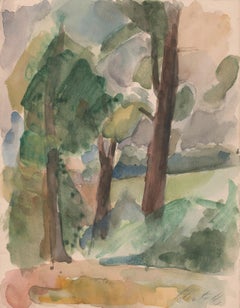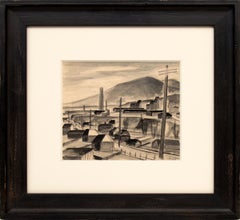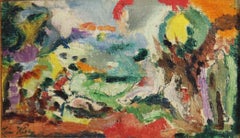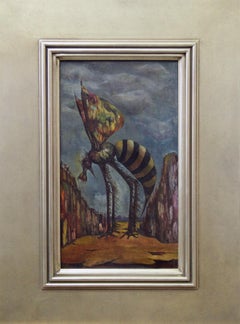Leon Kelly Landscape Paintings
American, 1901-1982
Leon Kelly, born in 1901, studied at the Pennsylvania Academy of the Fine Arts, Philadelphia. Awarded a traveling scholarship from that institution in 1924, he studied in Paris, France at the Grande Chaumiere. Other teachers included Arthur B. Carles, Jean Auguste Adolphe, Earl Horter and Alexandre Portinoff.
Essentially a Surrealist painter, Kelly did wide-ranging work that went from painterly to meticulous Surrealism, Cezanne-inspired watercolors, and Cubist painting. In the 1940s, Julian Levy, the Surrealist dealer, handled Kelly's work in New York City.
Kelly also exhibited at the Pennsylvania Academy of the Fine Art Annuals (1933-34, 1939-46, 1966); Corcoran Gallery Biennials, Washington, D.C. (three times from 1935-47); Art Institute of Chicago, Illinois; had a 1965 retrospective exhibition at the International Gallery, Baltimore, Maryland; Long Beach, New Jersey (1968); Richard Feigen Gallery, Chicago, Illinois (1968, 1970); Newark Museum, New Jersey (1969); and the Whitney Museum of American Art, New York.
Kelly's paintings are in the collections of three New York city museums, including the Metropolitan Museum of Art; Whitney Museum of American Art; and Museum of Modern Art; as well as Yale University Art Gallery, New Haven, Connecticut; Wadsworth Atheneum, Hartford, Connecticut; Pennsylvania Academy of the Fine Arts, Philadelphia; Cantor Arts Center, Stanford University, Palo Alto, California; Sara Roby Foundation Collection at the Smithsonian Institution, Washington, D.C.; Smith College Museum of Art, Northampton, Massachusetts; Sheldon Memorial Art Gallery, Lincoln, Nebraska; Newark Museum, New Jersey; and the Tel Aviv Museum, Israel.to
1
Overall Width
to
Overall Height
to
1
1
1
1
1
1
17
678
605
307
232
1
Artist: Leon Kelly
Landscape with Trees
By Leon Kelly
Located in Fairlawn, OH
Landscape with Trees
Watercolor on paper, 1929
Signed in pencil lower right corner
Obviously influenced by the Cezanne works in the collection of ...
Category
1920s American Modern Leon Kelly Landscape Paintings
Materials
Watercolor
Related Items
Society of Six Street Scene - Figurative Abstract
By Bernard Von Eichman
Located in Soquel, CA
Stunning New York City urban modernist watercolor titled "Summer Afternoon Stroll" by Society of Six artist Bernard Von Eichman (American, 1899-1990), 1...
Category
1930s American Modern Leon Kelly Landscape Paintings
Materials
Archival Paper, Watercolor
$6,076 Sale Price
20% Off
H 28 in W 22 in D 0.25 in
1940s WPA-Era Abstract Watercolor of Golden Cycle Mill by Charles Ragland Bunnel
By Charles Ragland Bunnell
Located in Denver, CO
This original 1940s grayscale watercolor by Charles Ragland Bunnell captures a semi-abstracted view of the Golden Cycle Mill in Colorado Springs, Colorado. Rendered in subtle blacks and grays, this striking WPA-era landscape melds industrial subject matter with a modernist aesthetic. The piece exemplifies mid-20th-century American regionalism, blending expressive abstraction with historical significance.
The painting measures 8 1/8 x 9 5/8 inches (sight size) and is showcased in a custom black frame measuring 18 x 19 ½ x 1 ⅜ inches, making it an elegant addition to any collection of American art or industrial landscapes.
The Golden Cycle Mining and Reduction Company was a vital part of Colorado’s early 20th-century mining boom, located in what is now Old Colorado City. Bunnell’s work documents this industrial heritage through a modernist lens, offering a unique narrative of regional development.
About the Artist:
Charles Ragland Bunnell (1897–1968) was a key figure in Colorado’s art scene and a pioneer of American Modernism and abstraction. Trained at Broadmoor Art Academy, he combined American Scene painting with abstract forms. Bunnell contributed to New Deal art...
Category
1940s American Modern Leon Kelly Landscape Paintings
Materials
Watercolor
$1,250 Sale Price
57% Off
H 18 in W 19.5 in D 1.5 in
Simka Simkhovitch WPA Artist Oil Painting Gouache American Modernist Powerline
By Simka Simkhovitch
Located in Surfside, FL
Simka Simkhovitch (Russian/American 1893 - 1949)
This came with a small grouping from the artist's family, some were hand signed some were not.
These were studies for larger paintin...
Category
1930s American Modern Leon Kelly Landscape Paintings
Materials
Oil, Gouache, Board
California Lake Landscape Original Watercolor on Paper
Located in Soquel, CA
California Lake Landscape in Watercolor on Paper
Serene landscape by Donna N. Schuster (American, 1883-1953). The viewer stands at the edge of a lake, under a few trees. At the far ...
Category
Early 20th Century American Modern Leon Kelly Landscape Paintings
Materials
Watercolor, Laid Paper
$2,275 Sale Price
35% Off
H 19 in W 23 in D 1.25 in
"Showers Today" San Francisco's Chinatown on an Overcast Day Original Watercolor
Located in Soquel, CA
"Showers Today" San Francisco's Chinatown on an Overcast Day Original Watercolor
A two sided watercolor on Arches paper by San Francisco and Maryland artist Harolod Gretzner (America...
Category
1970s American Modern Leon Kelly Landscape Paintings
Materials
Watercolor, Laid Paper
$1,722 Sale Price
35% Off
H 30 in W 37.63 in D 1.5 in
"Union Square" NYC American Scene Social Realism Modernism WPA Mid-20th Century
By Agnes Hart
Located in New York, NY
"Union Square" NYC American Scene Social Realism Modernism WPA Mid-20th Century
Agnes Hart (American, 1912-1979)
"Union Square, New York City"
Sight: 14 1/2 x 21 1/2 inches
Gouache...
Category
1940s American Modern Leon Kelly Landscape Paintings
Materials
Gouache, Board
Seoul, Korea
By Dong Kingman
Located in Los Angeles, CA
Seoul, Korea, 1954 - 56, watercolor on paper, signed lower right 21 x 28 inches (sight), Midtown Galleries label with artist’s name and title verso, likely exhibited at Kingman’s solo exhibition, Midtown Galleries, 1956, literature: Gruskin, Alan D., Saroyan, William (introduction), The Watercolors of Dong Kingman and How The Artist Works, The Studio Publications, Inc. in association with Thomas Y. Crowell Company, New York and London (1958), p. 54 (illustrated) (“In Seoul on April 27th and 28th Kingman did some mountain sketching [see reproduction, on page 54, of handsome Kingman painting, “Seoul,” owned by Robert Clary...
Category
1950s American Modern Leon Kelly Landscape Paintings
Materials
Paper, Watercolor
1950s "Figure in Shadow" Figurative Gouache Painting America Modernist
By Donald Stacy
Located in Arp, TX
Donald Stacy
"Figure in Shadow"
c.1950s
Gouache paint on paper
24" x 18" unframed
Unsigned
Came from artist's estate
Donald Stacy (1925-2011) New Jersey
Studied: Newark School of Fine Art
The Art Students League
Pratt Graphic Arts Center
University of Paris 1953-54
University of Aix-en-Provence 1954-55
Faculty: Art Department of the New School
Museum of Modern Art
School of Visual Arts
Stacy Studio Workshop
Exhibitions: Grand Central Moderns
George Wittenborn
The New School
Print Exhibitions, Chicago
University of Oklahoma
Honolulu Museum
Monclair Museum
Wisconsin State College
Louisiana Art...
Category
Mid-20th Century American Modern Leon Kelly Landscape Paintings
Materials
Paper, Gouache
"Lake by the Mountains" Watercolor American Modern Landscape by Edna Stoddart
Located in Pasadena, CA
A poetic vision of place, memory, and emotional color.
In this luminous Watercolor Landscape, Edna Stoddart transports us to a dreamlike valley where mountains cradle a winding rive...
Category
1950s American Modern Leon Kelly Landscape Paintings
Materials
Watercolor
$1,400
H 26.25 in W 30.25 in D 1 in
Orange Grove Landscape
By Dorr Bothwell
Located in Los Angeles, CA
Orange Grove Landscape, 1941, gouache on illustration board, 14 inches x 18 inches (image), 22 x 26 inches (framed) signed and dated lower right, newly framed with museum glazing
...
Category
1940s American Modern Leon Kelly Landscape Paintings
Materials
Gouache, Board
1950s "Mound Street" Mid Century Figurative Painting American Modernist
By Donald Stacy
Located in Arp, TX
Donald Stacy
"Mound Street"
c. 1950s
Gouache paint on paper
24" x 18'" unframed
Unsigned
Came from artist's estate
For sale is a striking black and white painting titled "Mound Stre...
Category
Mid-20th Century American Modern Leon Kelly Landscape Paintings
Materials
Paper, Gouache
$570 Sale Price
40% Off
H 18 in W 24 in
1950s "Purple Sky Landscape" Mid Century Abstract Landscape Painting
By Donald Stacy
Located in Arp, TX
Bearnice Fisher
"Purple Sky Landscape"
1978
Gouache on paper
30" x 22.5" unframed
Signed and dated lower right in pencil
Bearnice Fisher lived and worked in NYC
Category
Mid-20th Century American Modern Leon Kelly Landscape Paintings
Materials
Paper, Gouache
$1,800
H 22.5 in W 30 in
Previously Available Items
Modernist Abstract Landscape, Oil on Canvas, 1923, Signed and Dated, Framed
By Leon Kelly
Located in Doylestown, PA
"Abstract Landscape" by Philadelphia born modernist and surrealist painter Leon Kelly, is a small sized, framed landscape painting. The 5.5" x 9" oil on canvas is mounted to board, s...
Category
1920s American Modern Leon Kelly Landscape Paintings
Materials
Canvas, Oil, Board
H 9.5 in W 13 in D 1.5 in
Mosquito on Orange Mountain, Surrealist Landscape, Oil on Canvas, 1943, Framed
By Leon Kelly
Located in Doylestown, PA
"Mosquito on Orange Mountain" by Philadelphia born modernist painter Leon Kelly, is a framed, surrealist landscape painting. The 14" x 8" oil on canvas is signed on the lower right, ...
Category
1940s Surrealist Leon Kelly Landscape Paintings
Materials
Canvas, Oil
H 23 in W 17 in D 1.5 in
Leon Kelly landscape paintings for sale on 1stDibs.
Find a wide variety of authentic Leon Kelly landscape paintings available for sale on 1stDibs. You can also browse by medium to find art by Leon Kelly in paint, watercolor and more. Much of the original work by this artist or collective was created during the 1920s and is mostly associated with the modern style. Not every interior allows for large Leon Kelly landscape paintings, so small editions measuring 9 inches across are available. Customers who are interested in this artist might also find the work of Ben Benn, Frank Wilcox, and Francis Chapin. Leon Kelly landscape paintings prices can differ depending upon medium, time period and other attributes. On 1stDibs, the price for these items starts at $2,750 and tops out at $2,750, while the average work can sell for $2,750.




